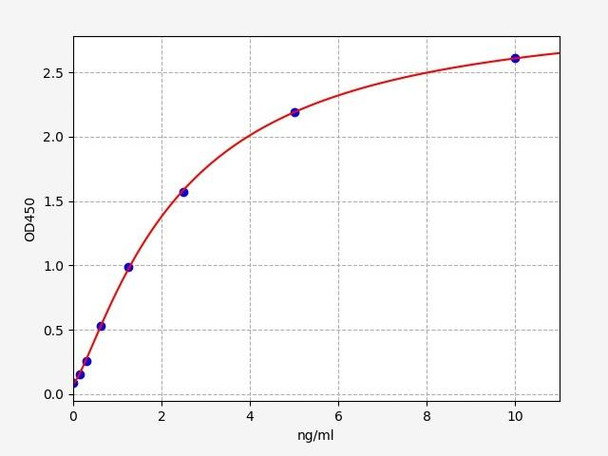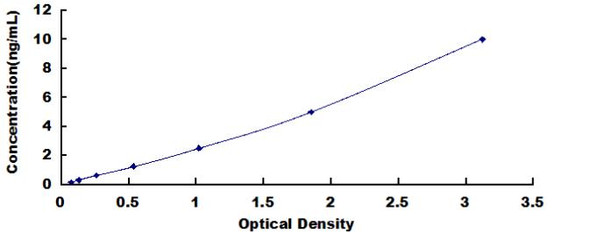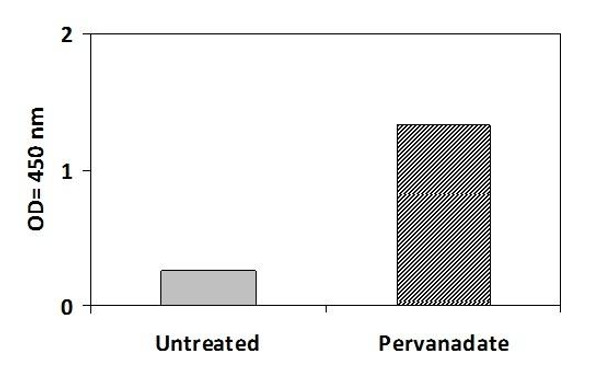Description
Mouse KIT/SCFR ELISA Kit
The Mouse SCFR (Stem Cell Factor Receptor) ELISA Kit is a powerful tool for accurately measuring SCFR levels in mouse serum, plasma, and cell culture supernatants. With its high sensitivity and specificity, this kit provides reliable and reproducible results, making it ideal for a variety of research applications.SCFR, also known as c-Kit or CD117, is a critical receptor involved in stem cell maintenance, hematopoiesis, and mast cell development. Dysregulation of SCFR signaling has been implicated in various diseases, including cancer and hematologic disorders.
By quantifying SCFR levels, researchers can gain valuable insights into disease mechanisms and potentially identify novel therapeutic targets.This Mouse SCFR ELISA Kit offers a user-friendly protocol and quick assay time, making it suitable for high-throughput screening and large-scale studies. Trust in the accuracy and precision of this kit to advance your research efforts in the fields of stem cell biology, cancer biology, and immunology. Invest in the Mouse SCFR ELISA Kit today and unlock the potential for groundbreaking discoveries.
| Product Name: | Mouse KIT/SCFR ELISA Kit |
| Product Code: | MOFI00137 |
| Size: | 96 Assays |
| Alias: | SCFR, c-Kit |
| Detection Method: | Sandwich ELISA |
| Application: | This immunoassay kit allows for the in vitro quantitative determination of Mouse SCFR concentrations in serum plasma and other biological fluids. |
| Sensitivity: | 0.094ng/ml |
| Range: | 0.156-10ng/ml |
| Storage: | 4°C for 6 months |
| Note: | For Research Use Only |
| Recovery: | Matrices listed below were spiked with certain level of Mouse SCFR and the recovery rates were calculated by comparing the measured value to the expected amount of Mouse SCFR in samples. | ||||||||||||||||
| |||||||||||||||||
| Linearity: | The linearity of the kit was assayed by testing samples spiked with appropriate concentration of Mouse SCFR and their serial dilutions. The results were demonstrated by the percentage of calculated concentration to the expected. | ||||||||||||||||
| |||||||||||||||||
| Intra Assay: | CV <8% | ||||||||||||||||
| Inter Assay: | CV <10% |
| Component | Quantity | Storage |
| ELISA Microplate (Dismountable) | 8×12 strips | 4°C for 6 months |
| Lyophilized Standard | 2 | 4°C/-20°C |
| Sample/Standard Dilution Buffer | 20ml | 4°C |
| Biotin-labeled Antibody(Concentrated) | 120ul | 4°C (Protect from light) |
| Antibody Dilution Buffer | 10ml | 4°C |
| HRP-Streptavidin Conjugate(SABC) | 120ul | 4°C (Protect from light) |
| SABC Dilution Buffer | 10ml | 4°C |
| TMB Substrate | 10ml | 4°C (Protect from light) |
| Stop Solution | 10ml | 4°C |
| Wash Buffer(25X) | 30ml | 4°C |
| Plate Sealer | 5 | - |
Other materials and equipment required:
- Microplate reader with 450 nm wavelength filter
- Multichannel Pipette, Pipette, microcentrifuge tubes and disposable pipette tips
- Incubator
- Deionized or distilled water
- Absorbent paper
- Buffer resevoir
| Uniprot | P05532 |
| UniProt Protein Function: | Kit: a receptor tyrosine kinase and a member of the subfamily that includes PDGF, CSF-1 and FLT-3/flk-2 receptors. Receptor for stem cell factor. Plays a critical role in hematopoietic stem cell, mast cell, melanocyte and germ cell development. Ligand binding induces autophosphorylation, dimerization and activation, leading to the recruitment and phosphorylation of downstream SH2-containing signaling components including PLC-gamma, PI3 kinase p85, SHP2 and CrkL, linking c-Kit to various cell signaling pathways. Molecular lesions that impair the kinase activity of c-Kit are associated with a variety of developmental disorders, while mutations that constitutively activate c-Kit can lead to hyperplasia and tumorigenesis. Activating mutations cause >90% of gastrointestinal stromal tumors (GIST); successfully treated with inhibitors Gleevec (imatinib, Glivec) and Sutent (Sutinib, SU11248). Activating mutations also induce mastocytosis. Autocrine/paracrine stimulation may drive some lung and other tumors. Loss of expression associated with melanoma progression. Familial loss of function mutations cause piebaldism, with defects in hair and skin pigmentation due to lack of melanocytes. |
| UniProt Protein Details: | Protein type:Oncoprotein; Protein kinase, tyrosine (receptor); Kinase, protein; Protein kinase, TK; Membrane protein, integral; EC 2.7.10.1; TK group; PDGFR family Cellular Component: acrosome; cell surface; cytoplasm; external side of plasma membrane; extracellular space; intercellular junction; internal side of plasma membrane Molecular Function:cytokine binding; protease binding; protein binding; protein homodimerization activity; protein-tyrosine kinase activity; stem cell factor receptor activity; transmembrane receptor protein tyrosine kinase activity Biological Process: actin cytoskeleton reorganization; activation of MAPK activity; cell differentiation; chemotaxis; cytokine and chemokine mediated signaling pathway; dendritic cell cytokine production; detection of mechanical stimulus involved in sensory perception of sound; embryonic hemopoiesis; epithelial cell proliferation; erythrocyte differentiation; germ cell development; germ cell migration; germ cell programmed cell death; glycosphingolipid metabolic process; gut development; hemopoiesis; immature B cell differentiation; inflammatory response; lamellipodium biogenesis; lymphoid progenitor cell differentiation; mast cell chemotaxis; mast cell cytokine production; mast cell degranulation; melanocyte differentiation; myeloid leukocyte differentiation; myeloid progenitor cell differentiation; negative regulation of programmed cell death; ovarian follicle development; peptidyl-tyrosine phosphorylation; pigmentation; pigmentation during development; positive regulation of cell migration; positive regulation of cell proliferation; positive regulation of JAK-STAT cascade; positive regulation of long-term neuronal synaptic plasticity; positive regulation of MAP kinase activity; positive regulation of MAPKKK cascade; positive regulation of Notch signaling pathway; positive regulation of pseudopodium formation; positive regulation of transcription factor activity; positive regulation of tyrosine phosphorylation of Stat1 protein; positive regulation of tyrosine phosphorylation of Stat3 protein; positive regulation of tyrosine phosphorylation of Stat5 protein; protein amino acid autophosphorylation; protein amino acid phosphorylation; regulation of cell shape; regulation of pigmentation during development; response to radiation; somatic stem cell division; somatic stem cell maintenance; spermatid development; spermatogenesis; stem cell differentiation; T cell differentiation; visual learning |
| NCBI Summary: | The c-Kit proto-oncogene is the cellular homolog of the transforming gene of a feline retrovirus (v-Kit). The c-kit protein includes characteristics of a protein kinase transmembrane receptor. Alternatively spliced transcript variants encoding different isoforms have been found for this gene. [provided by RefSeq, Jul 2008] |
| UniProt Code: | P05532 |
| NCBI GenInfo Identifier: | 353526329 |
| NCBI Gene ID: | 16590 |
| NCBI Accession: | P05532.3 |
| UniProt Secondary Accession: | P05532,Q61415, Q61416, Q61417, Q6LEE9, Q6QJB7, Q6QJB8 Q7TS86, Q8C8K9, |
| UniProt Related Accession: | P05532 |
| Molecular Weight: | 22,814 Da |
| NCBI Full Name: | Mast/stem cell growth factor receptor Kit |
| NCBI Synonym Full Names: | kit oncogene |
| NCBI Official Symbol: | Kit |
| NCBI Official Synonym Symbols: | W; Bs; Fdc; Ssm; SCO1; SCO5; SOW3; CD117; c-KIT; Tr-kit; Gsfsco1; Gsfsco5; Gsfsow3 |
| NCBI Protein Information: | mast/stem cell growth factor receptor Kit |
| UniProt Protein Name: | Mast/stem cell growth factor receptor Kit |
| UniProt Synonym Protein Names: | Proto-oncogene c-Kit; Tyrosine-protein kinase Kit; CD_antigen: CD117 |
| Protein Family: | Kit ligand |
| UniProt Gene Name: | Kit |
| UniProt Entry Name: | KIT_MOUSE |
*Note: Protocols are specific to each batch/lot. For the correct instructions please follow the protocol included in your kit.
| Step | Procedure |
| 1. | Set standard, test sample and control (zero) wells on the pre-coated plate respectively, and then, record their positions. It is recommended to measure each standard and sample in duplicate. Wash plate 2 times before adding standard, sample and control (zero) wells! |
| 2. | Aliquot 0.1ml standard solutions into the standard wells. |
| 3. | Add 0.1 ml of Sample / Standard dilution buffer into the control (zero) well. |
| 4. | Add 0.1 ml of properly diluted sample (Human serum, plasma, tissue homogenates and other biological fluids.) into test sample wells. |
| 5. | Seal the plate with a cover and incubate at 37 °C for 90 min. |
| 6. | Remove the cover and discard the plate content, clap the plate on the absorbent filter papers or other absorbent material. Do NOT let the wells completely dry at any time. Wash plate X2. |
| 7. | Add 0.1 ml of Biotin- detection antibody working solution into the above wells (standard, test sample & zero wells). Add the solution at the bottom of each well without touching the side wall. |
| 8. | Seal the plate with a cover and incubate at 37°C for 60 min. |
| 9. | Remove the cover, and wash plate 3 times with Wash buffer. Let wash buffer rest in wells for 1 min between each wash. |
| 10. | Add 0.1 ml of SABC working solution into each well, cover the plate and incubate at 37°C for 30 min. |
| 11. | Remove the cover and wash plate 5 times with Wash buffer, and each time let the wash buffer stay in the wells for 1-2 min. |
| 12. | Add 90 µL of TMB substrate into each well, cover the plate and incubate at 37°C in dark within 10-20 min. (Note: This incubation time is for reference use only, the optimal time should be determined by end user.) And the shades of blue can be seen in the first 3-4 wells (with most concentrated standard solutions), the other wells show no obvious color. |
| 13. | Add 50 µL of Stop solution into each well and mix thoroughly. The color changes into yellow immediately. |
| 14. | Read the O.D. absorbance at 450 nm in a microplate reader immediately after adding the stop solution. |
When carrying out an ELISA assay it is important to prepare your samples in order to achieve the best possible results. Below we have a list of procedures for the preparation of samples for different sample types.
| Sample Type | Protocol |
| Serum: | If using serum separator tubes, allow samples to clot for 30 minutes at room temperature. Centrifuge for 10 minutes at 1,000x g. Collect the serum fraction and assay promptly or aliquot and store the samples at -80°C. Avoid multiple freeze-thaw cycles. If serum separator tubes are not being used, allow samples to clot overnight at 2-8°C. Centrifuge for 10 minutes at 1,000x g. Remove serum and assay promptly or aliquot and store the samples at -80°C. Avoid multiple freeze-thaw cycles. |
| Plasma: | Collect plasma using EDTA or heparin as an anticoagulant. Centrifuge samples at 4°C for 15 mins at 1000 × g within 30 mins of collection. Collect the plasma fraction and assay promptly or aliquot and store the samples at -80°C. Avoid multiple freeze-thaw cycles. Note: Over haemolysed samples are not suitable for use with this kit. |
| Urine & Cerebrospinal Fluid: | Collect the urine (mid-stream) in a sterile container, centrifuge for 20 mins at 2000-3000 rpm. Remove supernatant and assay immediately. If any precipitation is detected, repeat the centrifugation step. A similar protocol can be used for cerebrospinal fluid. |
| Cell culture supernatant: | Collect the cell culture media by pipette, followed by centrifugation at 4°C for 20 mins at 1500 rpm. Collect the clear supernatant and assay immediately. |
| Cell lysates: | Solubilize cells in lysis buffer and allow to sit on ice for 30 minutes. Centrifuge tubes at 14,000 x g for 5 minutes to remove insoluble material. Aliquot the supernatant into a new tube and discard the remaining whole cell extract. Quantify total protein concentration using a total protein assay. Assay immediately or aliquot and store at ≤ -20°C. |
| Tissue homogenates: | The preparation of tissue homogenates will vary depending upon tissue type. Rinse tissue with 1X PBS to remove excess blood & homogenize in 20ml of 1X PBS (including protease inhibitors) and store overnight at ≤ -20°C. Two freeze-thaw cycles are required to break the cell membranes. To further disrupt the cell membranes you can sonicate the samples. Centrifuge homogenates for 5 mins at 5000xg. Remove the supernatant and assay immediately or aliquot and store at -20°C or -80°C. |
| Tissue lysates: | Rinse tissue with PBS, cut into 1-2 mm pieces, and homogenize with a tissue homogenizer in PBS. Add an equal volume of RIPA buffer containing protease inhibitors and lyse tissues at room temperature for 30 minutes with gentle agitation. Centrifuge to remove debris. Quantify total protein concentration using a total protein assay. Assay immediately or aliquot and store at ≤ -20 °C. |
| Breast Milk: | Collect milk samples and centrifuge at 10,000 x g for 60 min at 4°C. Aliquot the supernatant and assay. For long term use, store samples at -80°C. Minimize freeze/thaw cycles. |







